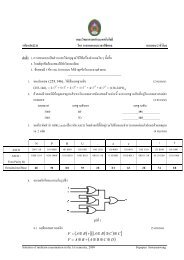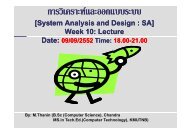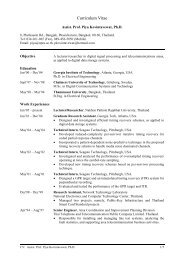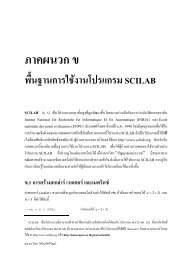An Application of SPC and PCA in a Product Manufacturing: Energy ...
An Application of SPC and PCA in a Product Manufacturing: Energy ...
An Application of SPC and PCA in a Product Manufacturing: Energy ...
Create successful ePaper yourself
Turn your PDF publications into a flip-book with our unique Google optimized e-Paper software.
consum<strong>in</strong>g steps are selected. These are shown <strong>in</strong> Fig. 7 where<br />
the process step <strong>and</strong> its correspond<strong>in</strong>g average test times are<br />
plotted.<br />
Distribution <strong>of</strong> the raw-collected data (V073) is shown <strong>in</strong><br />
Fig. 4 <strong>in</strong> the previous section. The non-normal distribution can<br />
be clearly observed. With Box <strong>and</strong> Cox transformation def<strong>in</strong>ed<br />
by eqn. (13), the new distribution is shown <strong>in</strong> Fig. 9 where the<br />
transform parameter was set to = 0 .<br />
This transformation estimates the DPPM to be 68,000<br />
pieces or 6.8%. The process capability C pk<br />
<strong>of</strong> 0.53 is obta<strong>in</strong>ed<br />
as USL was set to 6σ (USL=12.48 m<strong>in</strong>.). The control is set to<br />
one side specification (us<strong>in</strong>g only upper specification limit).<br />
Fig. 7 Pareto chart <strong>of</strong> major sub-processes<br />
Drives are classed to Pass <strong>and</strong> Fail accord<strong>in</strong>g to the time<br />
limited set for the tester. For a particular test<strong>in</strong>g step “D036”,<br />
as a case, <strong>in</strong>dividual unit test times is shown <strong>in</strong> Fig. 8 below.<br />
Fig. 9 Process capability <strong>of</strong> Box-Cox transformed data<br />
Box-Cox transformation parameter can be made varied as<br />
shown <strong>in</strong> Table II. By compar<strong>in</strong>g the process capability <strong>in</strong>dices<br />
<strong>and</strong> defective part per million (DPPM) for each lambda, the<br />
optimal one can be selected.(expla<strong>in</strong> more: what is Observed,<br />
with<strong>in</strong> <strong>and</strong> overall)<br />
Fig. 8 D036 <strong>in</strong>dividual unit test times (m<strong>in</strong>.)<br />
Refer to the said figure, we can clearly note the variance<br />
<strong>and</strong> range <strong>of</strong> data <strong>in</strong> each groups. The fail group holds larger<br />
variation. Regard<strong>in</strong>g this observation we can use the data <strong>of</strong> the<br />
pass group to def<strong>in</strong>e the statistic parameters.<br />
The extracted data were tested for their normality by<br />
exam<strong>in</strong><strong>in</strong>g the P-value. The obta<strong>in</strong>ed results are shown <strong>in</strong> table<br />
I (second row). Those with P-value less than 0.005 are assumed<br />
to have non-normality distribution <strong>and</strong> must be transformed for<br />
<strong>SPC</strong> <strong>and</strong> <strong>PCA</strong> applications. After transformation (with = 0 )<br />
the correspond<strong>in</strong>g P-value is shown <strong>in</strong> the third row.<br />
TABLE I<br />
NORMALITY TEST OF THE DISTRIBUTION (P-VALUE)<br />
Proc. V020 D036 V037 S055 V071 V073<br />
Before












